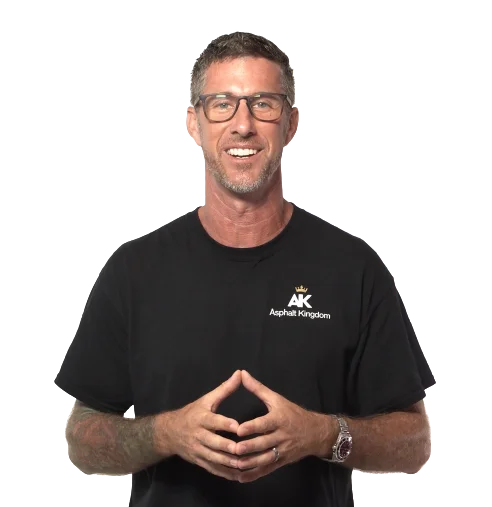It's summer and in many parts of the country, temperatures are soaring beyond the 90s. Although summer's the best time to sealcoat driveways and fill cracks, excessive heat can be bad news for you and your crew.
According to the CDC, more than 10,000 people died due to excessive heat exposure during the spring and summer months between 2004 and 2018. Males working outdoors, in particular, are at high risk from common heat-related conditions, such as heat cramps, heat exhaustion, and heat stroke.
If this is your first season as an asphalt maintenance contractor or you've been working for many years in the industry but the heat still gets to you, then this blog is for you. Read about the different precautions you have to take, and implement them to prevent injuries and death in the workplace.
1. Take note of the heat index
We always tell you to watch out for precipitation before you leave to sealcoat parking lots or fix cracks. But precipitation is not the only thing you should look out for. This summer, checking the day's heat index value is also important to you and your crew's safety.
But what exactly is heat index, and what's the big deal about it?
When we check weather forecasts, the first thing we look at is air temperature. But we often neglect to check (or are unaware of) how hot it really feels to our bodies. This "real feel" is the heat index, and it is a measure of how hot it truly feels for the human body when you factor in the day's overall air temperature and humidity.
The air is naturally more humid during the summer months. When it's more humid, sweat evaporates slower from our bodies, and this makes us feel hotter and more uncomfortable. A higher heat index also makes us more susceptible to heat cramps, heat exhaustion, and even heat stroke when we work outdoors.
Related: How Proper Asphalt Maintenance Can Prevent Parking Lot Accidents
So how do you check the heat index, and how does being aware of it help you prevent heat-related illnesses at work?
Weather apps and websites are your best friend when it comes to heat index and humidity information. The National Weather Service, for example, issues daily forecasts not just for air temperature but also for heat index and humidity.
You can download an app or visit your preferred website daily to check these information, and make sure that you and your crew are safe when you work this summer.
Read this handy guide to learn more about heat index values, what you should look out for, and how asphalt maintenance contractors like you can stay safe this summer.
If you're a sealcoater in Canada, then check your city's humidex section on the Meteorological Service of Canada's website. Learn about humidex and other things you should look out for in this OSH fact sheet.
2. Don appropriate workwear
You'll be working under the hot summer sun for eight hours or more, so make sure that you dress appropriately. Check out the list below for your standard sealcoater personal protective workwear this summer.
1. Wear loose-fitting long-sleeved shirts. We recommend long-sleeved tees made of light, breathable, and moisture-wicking fabrics, such as cotton, cotton-polyester blend, and polyester birdseye mesh.
Ran out of long-sleeved tees? Then go ahead and wear a short-sleeved one. Just make sure to wear a pair of protective arm sleeves to shield your skin from the sun.
2. Wear long pants. But if you want to wear shorts instead, then make sure to wear a pair of compression pants underneath them or some over-the-calf socks to protect your legs from sunburn.
3. Apply sunscreen to exposed skin to prevent sunburn and skin cancer. Don't scrimp on the good stuff – use sunscreen with SPF30 or higher if you're sealcoating and filling cracks all day long. Slather sunscreen on your face, ears, neck, and hands 30 minutes before you go out and reapply every two hours.
4. Wear a wide-brimmed hat to protect your neck, face, eyes, and ears from the sun's UV rays. Ditch that baseball cap or regular bucket hat because they only shield a small portion of your face and neck. Choose a hat with a drawstring so it won't be swept away by a gust of wind.
5. Don a pair of sunglasses with UV protection. Did you know that prolonged and frequent sun exposure can increase your risk of cataract and can cause wrinkles to appear around your eyes? With a pair of UV sunglasses, you can look cool and protect your eyes at the same time.
3. Stay hydrated throughout the day
Drink water before you head out to work, and always have drinking water close by while you're working to prevent dehydration. Bring a large water bottle if you're working solo.
If you have your crew with you, then it's best to bring a large plastic water container or sports cooler to keep hydrated.
Don't wait until you're thirsty before you drink water. You're already almost dehydrated by the time you feel thirsty, so take small sips of water throughout the day.
Refrain from drinking caffeinated beverages or sugary drinks. You can drink a bottle of sports or electrolyte drinks if you wish, but make sure that they have low sugar content, and you still drink plenty of water throughout the day.
A can of ice-cold beer might be tempting during a hot day, but alcohol is dehydrating and definitely a no-no in the workplace.
4. Take short breaks frequently
Working outdoors in the heat can increase your chances of dehydration and heat exhaustion. Make sure to take short breaks throughout the day, and find a shady place for you and your crew to cool down.
5. Schedule work during cooler times of the day
If you don't have a full sealcoating or crack repair schedule, then it's best to work during times when the day is much cooler (6 AM to 9 AM and 3 PM to 6 PM).
But if you really have to work between 9 AM and 3 PM, then it's best to follow other precautionary measures we mentioned here to make sure you're safe all day long.
Related: Getting The Most Out of Your Old Asphalt Equipment
6. Reduce contact with equipment that emits a lot of heat
Any equipment that emits heat can worsen the effects of prolonged exposure to heat and humidity. If you're using a crack filling machine, then make sure to operate the machine only during cooler times of the day.
Stand a few feet away from an infrared asphalt heater while it's turned on. Rotate employees if you have to to minimize their exposure to the heat of the sun and the equipment at the same time.
7. Have an emergency plan in place
Make sure that your employees know about the hazards of working outdoors in the summer and the precautions they can take to protect themselves.
Ensure that your crew can identify the first signs and symptoms of heat cramps, heat exhaustion, and heat stroke. Always bring a first aid kit on-site and ensure that you and your team know how to administer basic first aid for heat-related illness. Watch this video to learn more about heat stress and how to administer first aid.
Call 911 immediately if your coworker doesn't get better or if you notice symptoms of heat stroke.
Conclusion:
It's hard to make money from asphalt maintenance if you're injured or unhealthy. So follow these safety tips to make sure that you have a lucrative and illness-free season.









